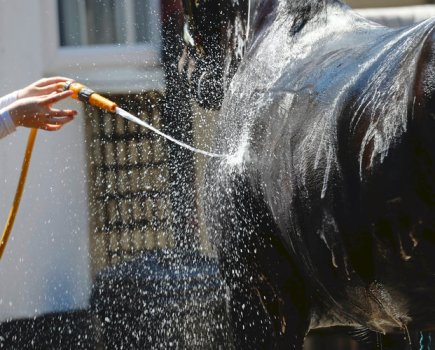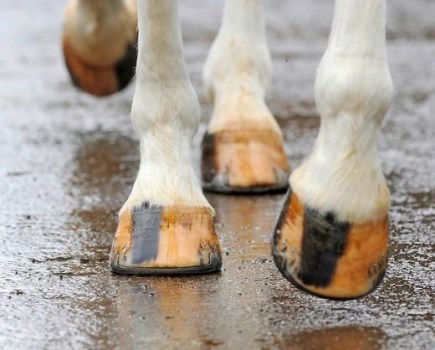It’s a question that every horse owner and rider asks themselves at some stage: is my horse lame? The answer isn’t always easy to work out, because lameness isn’t always easy to see, let alone narrow down to exactly which limb is causing the problem.
Without any swelling, heat or wound on a leg to go on, how to tell if a horse is lame means watching them move.
Every horse has their own specific conformation and action. Lameness is defined as any change in a horse’s usual way of moving, so knowing what is normal for your horse will help you decipher if and how lame they are.
Whether slight or severe, lameness is usually a sign of pain or discomfort and identifying the root cause is essential for getting your horse sound again.
How to tell if a horse is lame
If you suspect your horse might be lame, you will need to trot them up.
On a solid, level surface, ask a competent handler to lead your horse on a fairly loose rein, so that their head is not restricted while they’re moving.
Watch the horse walk and trot away from you and then towards you on a straight line. If the lameness isn’t clear, watch them walk and trot on a circle too.
It takes an experienced and trained eye to instantly detect which is leg lame. The following will help you to work it out:
To detect forelimb lameness
Watch for your horse’s head nodding. As the sound leg bears weight (ie touches the ground), the horse’s head will go down.
As the sore leg bears weight, the head will go up. So if the horse is lame in the near fore, their head will go up as the front left leg hits the ground.
To detect hindlimb lameness
Stand behind your horse and watch the point of your horse’s hip rise and fall.
If there is any hindlimb lameness, the hock and hip of the affected leg may be carried higher and so the point of hip on this side will raise higher than the other side.
Other ways to detect lameness
Listen to the sound of your horse’s hooves as they hit the ground. The horse will put less weight on the painful hoof when they land and so it will sound quieter.
You can also observe your horse moving from the side and look for variations in their length of stride.
If there is only a subtle amount of lameness, watch them move on a circle, preferably on the lunge.
Working a horse on a circle is more demanding than working in a straight line, so any lameness will show up more clearly.
Grades of lameness
You’ll often hear vets describe a horse as being ‘two tenths’ (or similar figure) lame.
Grading the severity of a horse’s lameness on a scale of 0 to 5 can make it easier to monitor your horse’s condition. It will also help you to describe how lame they are when speaking to a vet.
Use the following as a guide:
- 0 — Sound
- 1 — Barely detectable lameness at walk and trot
- 2 — Mild lameness at walk, obvious lameness at trot
- 3 — Obvious lameness at trot
- 4 — Severe lameness at walk, unwillingness to trot
- 5 — Non-weight bearing lameness
Signs of discomfort in a lame horse
Knowing how to tell if a horse is lame isn’t always easy. Sometimes horses are obviously lame with a moderate to severe limp, but low-grade lameness can be easy to miss. Look out for the following signs that could indicate your horse is uncomfortable:
Deteriorating performance
Your horse might not perform specific movements as well as usual, such as not wanting to go forwards, preferring one rein to the other, or feeling less powerful.
Not accepting the contact
A well schooled horse who regularly works in a correct outline may show signs of discomfort by suddenly refusing to work in an outline. Instead they might prefer to work above or behind the bit, as it is more comfortable. Alternately the horse may feel heavier in your hand or be fussier/fight the contact.
Changes in behaviour
A horse who is in pain can show their discomfort through a change in behaviour. For example, a horse with sore hocks will find flexion of hindlimbs painful and so they may become difficult for the farrier or when their feet are picked out.
A horse with a painful tendon may move away from your touch.
Your horse may just seem generally grumpy and off colour to be around too. Don’t dismiss this. You know your horse best and small changes like this can flag a problem while it is still in its early stages — this is an important part of how to tell if a horse is lame.
Showing signs of pain
This could be opening their mouth, twisting the head, swishing the tail or putting their ears back — both when they’re being ridden and when they’re not. Hindlimb lameness can also cause your saddle to slip.
Investigating a lame horse
When trying to work out where lameness is coming from, start with your horse’s feet. The majority of lameness originates in the hoof, so eliminate the most obvious potential causes first.
- Stand your horse on a level surface. Pick their feet out and check for any stones that may have become lodged in the sole, frog groove or underneath the shoe.
- Check each hoof for any sharp objects that could have worked their way into the sole of the foot or signs of a puncture wound, where your horse may have stood on something sharp.
- Feel for heat in the hoof wall and any sign of injury on the outside of the hoof.
If you can’t find anything in the hooves, the next step is to run your hands up the leg, feeling for heat around the coronary band and the heel. Then check for heat and swelling in between the fetlock and the knee or hock. The horse’s knee, elbow and shoulder in each foreleg, plus the hock, stifle and hip in the hindlegs, will also need to be examined for heat and swelling.









